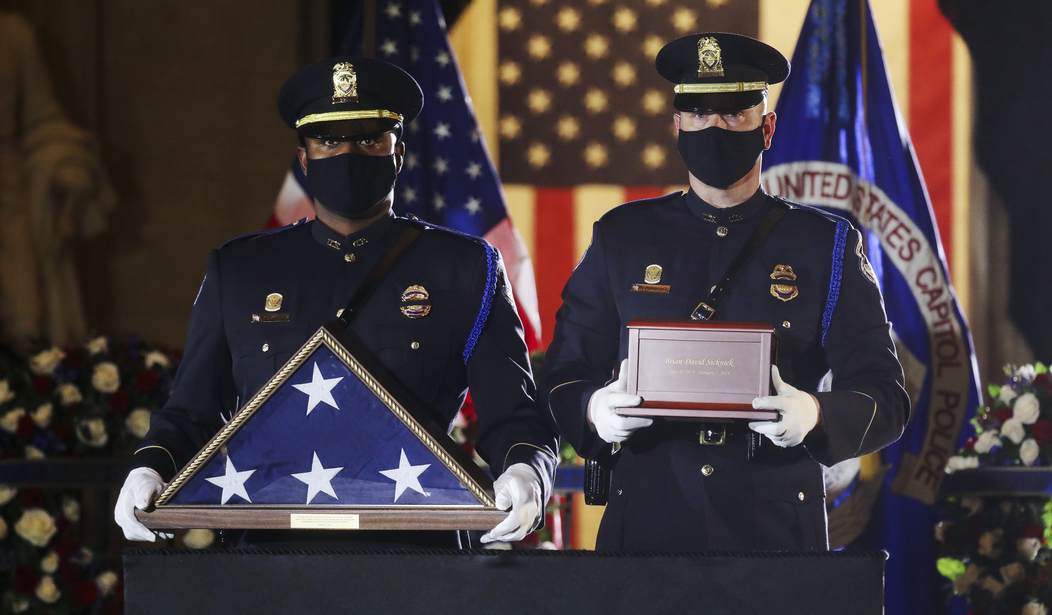Why do we at RedState do our best to debunk false narratives? Because they do so much damage not only in driving people’s perspective, but sadly, they also affect how law enforcement does its job.
Case in point: The January 6 unrest and Officer Brian Sicknick. Bonchie, ShipwreckedCrew, Nick Arama, and our other contributors have not only followed how the false narrative that Officer Sicknick was struck by the Capitol rioters with a fire extinguisher and killed started, but how it was continually reinforced by legacy media.
As the investigation disproved the narrative, the media had to do walk backs. Shipwreckedcrew wrote about that walking back by the New York Times and CNN:
The story claiming that a police officer was murdered by Trump supporters during the Capitol Hill protest on January 6 is, for all practical purposes, retracted by the NYT the day after Pres. Trump is acquitted on the impeachment charge of having instigated those protests — which were declared by Democrats and the media an “insurrection” against the government.
If you search for the original NYT story today, you find the following “Note” now at the top:
UPDATE: New information has emerged regarding the death of the Capitol Police officer Brian Sicknick that questions the initial cause of his death provided by officials close to the Capitol Police.
Julie Kelly at American Greatness has been aggressively pursuing this story for weeks, and two days ago she published a column that noted efforts by media outlets — including the NYT — to slowly back away from narrative created by the early reporting done by the NYT and acknowledging that the cause of Sicknick’s death was still undetermined. (We’ve also reported on CNN’s about-face here.) The narrative built around that early reporting was that he was struck by a demonstrator wielding a fire extinguisher — a narrative advanced by both liberal and conservative media outlets in their effort to railroad Donald Trump over the past 5 weeks. That narrative has now unraveled because there simply is no evidence to support the claim that the fire extinguisher episode actually happened.
And because that narrative was discarded by law enforcement, they were able to hone in on different causations. Bonchie addressed a possible suspect being looked into by law enforcement now that they had a different causation:
The case of Officer Brian Sicknick, who died sometime after the January 6th riot, has perplexed investigators and the media alike for almost two months now.
The original story, spread by a now provably false report from ABC News, was that he had been viciously beaten with a fire extinguisher. Early on, the lack of evidence for such a claim became apparent. That was confirmed about a month later when authorities revealed that the autopsy had not found any blunt force trauma. Clearly, the FBI knew that information from the very beginning, which makes it all the more odd that everything was so tightly held.
(see Tucker Carlson Lays out Some Uncomfortable Questions About the Capitol Riot)
After the revelation that the press had spread a false death story about Sicknick, reports then said that investigators were focusing on a possible reaction to pepper spray. That might end up closer to the truth if the latest news is any indication.
Much closer, and law enforcement finally hit a more credible target. On March 15, CNN reported on the men who wielded that spray against Officer Sicknick being arrested and charged. However, the media outlet still could not stop themselves from re-inserting that false narrative back into the conversation:
Two men have been arrested and charged for assaulting US Capitol Police Officer Brian Sicknick, who died after responding on January 6 to hundreds of rioters who stormed the Capitol, the Justice Department announced Monday.
Julian Elie Khater, 32, of Pennsylvania, and George Pierre Tanios, 39, of West Virginia, are alleged to have worked together to spray police, including Sicknick, with a toxic chemical spray during the Capitol riot. Khater called what was in the cannister “bear sh*t,” according to court records, but the Justice Department on Monday said the spray is unknown.
Investigators had struggled for weeks to build a federal murder case in Sicknick’s death as they pored over video and photographs to try to determine the moment in which he suffered his fatal injuries. Investigators determined that initial reports suggesting Sicknick had been struck with a fire extinguisher weren’t true.
So here is the shading that keeps this myth of Officer Brian Sicknick being “murdered” active. How do we know this was the moment he “suffered his fatal injuries” if the details of what caused his death have not been made public?
Newsweek did a fact check back in February which confirms that we still do not know what Officer Sicknick died from:
The U.S. Capitol Police announced that Officer Sicknick died around 9:30 p.m. January 7 “due to injuries sustained while on-duty” following the insurrection in a statement released the night he died.
Sicknick “was injured while physically engaging with protestors,” the statement said. “He returned to his division office and collapsed. He was taken to a local hospital where he succumbed to his injuries.”
There have been few official details released since Sicknick’s death. The investigation by Capitol police, the DC Metropolitan Police Department’s homicide branch and federal law enforcement officials is ongoing.
And as far as we know, this is still the case. According to another Nick Arama investigation:
This is really media malpractice, completely leading millions to believe something that was untrue, that they should at least have reported as a question, not a determined fact as they have now for a month.
His family asked for his death not to be politicized, but some Democrats and some in media have completely ignored that over this time.
This is the problem with false narratives—they are hard to get rid of, and people refuse to let them go, even when given the truth.
Case in point:
Last night on Fox News Donald Trump officially embraced political violence as he defended the people who attacked the Capitol on Jan 6 and killed a cop and injured 140 more as America loving patriots. Trump and the GOP are Fascism. Donald Trump is a terrorist
— (((DeanObeidallah))) (@DeanObeidallah) March 26, 2021














Join the conversation as a VIP Member